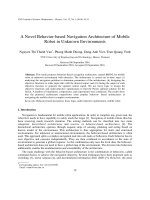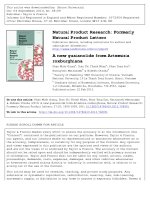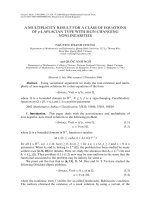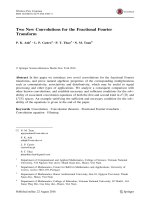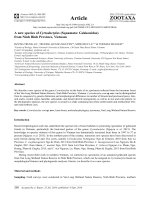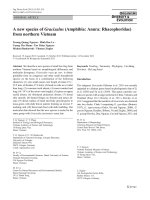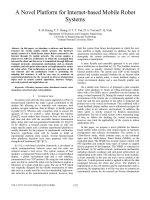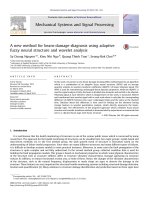DSpace at VNU: A new formulation for fast calculation of far field force in molecular dynamics simulations
Bạn đang xem bản rút gọn của tài liệu. Xem và tải ngay bản đầy đủ của tài liệu tại đây (1.29 MB, 9 trang )
VNƯ Joumal of Science, Mathematics - Physics 23 (2007) 122-130
GA-based dynamic survivable routing in WDM optical
networks with shared backup paths
Vinh Trong Le*
Department o f Maíhematics, Mechanics and Ịnformatics, College o f Science, VNU
334 Nguyen Trai, Thanh Xuan, Hanoi, Vietnam
Received 15 November 2006; received in revised form 2 August 2007
Abstract. This paper considers the problem of dynamic survivable routing in WDM networks with
single link íailure model. This work mainly concems in how to dynamically đetermine a
protection cycle (i.e., two link-disjoint paths between a node pair) to establish a dependable
lightpath with backup paths sharing. The problem is identified as NP-complcte, thus a heuristic for
fmding near optimal solution with reasonable computation timc is usually preferred. Inspired from
the principle of genetic algorithms (GA), a GA-based survivable routing algorithm for the problcm
with a new íìtness íunction, which allows us to improve blocking períormance, will be proposed.
Extensive simulation results upon the ns-2 network simulator and two typical netvvork topologics
show that our algorithm can achieve a signiíìcantly lower blocking probability than conventional
algorithms.
1 . Introduction
The optical networks using wavelength division multiplexing (WDM) could providc huge
bandwidth capacity for ncxt-generation Internet. Thcse networks are promising candidate to mcel the
bandvvidth demands from various emerging multimedia applications such that web applications, video
on demand, multimedia coníerence, image access and distribution, home broadband services ctc. [ 1 ]
Fig. 1. Architecture of a vvavelength-routed network.
An all-optical WDM network consists of optical cross-connects (OXCs) interconnectcd by fiber
links, in which an o x c can switch an optical signal from an input to an output link vvithout
■TcL 84-4-8581135
E-mail:
122
Vinh Trong Le / VNU Journal o f Science, Mathematics - Physics 23 (2007) 122-130
123
perforrning optoelectronic conversion. End-users communicate vvith each other via all-optical
channels, which are reícrred to as ỉightpaths as shown in Fig 1. A lightpath is an optical channel that
spans multiple lìber links to provide a connection between two network nodes. If there are no
vvavelength converters, a same vvavclength must be used along a lightpath, which reíerred to the
wavelength continuity constraint. An o x c cquipped with wavelength converters is capable of
changmg the wavelength of incoming signal, so a lightpath can use many wavelengths on it. However,
duc to the technology requirement, the wavelength conversion cost is very expensive. This work just
considers the case where the same wavelength must be used along a lightpath.
1.1. R outing and yVavelength Assignment
Given a set of connection requests, the problcm of setting up lightpaths by routing and
assigning a vvavelength to each connection is called routing and \vavelength assignment (RWA)
problem [1]. If we cannot setup a lightpath for a connection request, then it is blocked. A welldesigned RWA algorithm is critically important to improve the pcríbrmance of WDM netvvorks.
RWA problem can be classiíìed into static and dynamic problems. In the static problem, the
connection requests are given in advance. The static is always períbrmed offline, the objective is to
minimize the total blocking probability or to have the maximum number of setting up connections.
This problem can be íbrmulated as mixcd-integer linear program, which is NP-complete [1]. In
contrast, the dynamic RWA considers the case wherc connection requests arrive dynamically. The
dynannic RWA is performed Online, it is much more challenging; therefore, heuristic algorithms are
usually employcd in resolving this problem [1 ].
This work íocuses on dynamic RWA problem. In literature, there are static routing approaches
available for the dynamic RWA problem, such as shortest-path routing or altemate shortest-path
routing [1]. These approaches use a set of prc-computed shortest paths for lightpath establishment. The
advantage of these approaches is its simplicity, e.g. small Setup time and low control overhead.
Adaptũve routing approaches [1] are more efficient than static routing methods in terms of blocking
probability, becau se the ro u te is chosen adaptively d epending on the netvvork State, and ou r approach
follows this approach.
1.2. Survivabỉe Routing in W DM Networks
The íailure in optical communication networks such as accidental fiber link disruption or
switching device disorder will affect a huge amount of bandwidth in transmission, thus survivability is
onc 0 f the most important issues in the design of WDM optical networks [2]. Two major techniques to
prevent failures are protection and restoration [3]. In protection schemes, backup resources are precomp'Uted and reserved for each connection before a failure occurs. In restoration schemes, the backup
route is dynamically computed after the failure occurs. In compare with restoration schemes,
protection schemes have a faster recovery time and can guarantee 100% of recovery ability, but
requiire more network resources.
Protection schemes are divided into path protection and fìnk protection. In the íormer, a
work:ing path and a link-disjoint protection path are pre-com puted for each connection. In the later,
each link of the working path is protected by separate backup resources. Path protection schemes
124
Vinh Trong Le / VNU Journal o f Science, Mathematics - Physics 23 (2007) 122-130
usually require lower backup resources and lovver recovery dclay than link protection [3]. The pair of
working and protection paths forms a protection cycle between two network nodes. The routing
problem that tries to determine a vvorking path and a protection path for a connection request in
dynamic WDM networks is reíerred to dynamic survìvable routing. A connection that is Setup from
this cycle is called a dependable connection. Protection schemes can be ĩurther classiíied into
dedicated protection and shared protection. In the íbrmer, the backup resources such as links or nodes
are used for at most one connection. In the later, the backup resources can bc used for multiple
connections, because these connections rarely fail simultaneously. Dcdicated protection consumes
more resource but is simpler to implement. In contrast, share protection is morc effĩcicnt but more
complex for management [3, 4].
There are two kinds of failure in WDM networks: link failure and node failure. It is observed
that most modem switching devices are equipped with built-in rcdundancy to improve their reliability.
Therefore, link failure is morc concem than node failure. Many studies in thc literature justify that
single link failure happens much more frequcntly than multiple link ĩailures, thus thc singlc link
failure model attract more attentions in the optical survivability rcsearch.
1.3. Motivation and Contribution
In this paper, the problem o f dynam ic routing and w avelength assignm ent with lightpath
protection (survivable routing) in WDM mesh networks is considered. The path protection schcmc
with shared backup resource is adopted and thc single link failure model is concemcd.
Many rescarchcrs proposed optimal approachcs by íormulating this problcm as an Intcgcr
Lincar Program (ILP), thus it is NP-complete [5]. Hovvever, it is not practical to solve such ILP
problem by optimal approach because the dynamic connection sctup requires a low computation time.
To achieve that goal, these authors also proposed several heuristics to solve this problem.
In [3], Mohan et al. proposed an efficient protection scheme called primary independent backup
wavelength assignmcnt (PIBWA). This method uses the sharcd protcction scheme by adopting the
backup multiplexing technique. In PIBWA algorithm, a set of k link-disjoint paths is pre-computcd for
every source-destination node pair. Whenever a connection request arrives, a working (primary) path
and a backup path with total minimizcd cost arc selectcd from these k paths. If such working-backup
path-pair has no wavelength available then the conncction request is blocked. The PIBWA with
backup multiplexing tcchnique is simple but can still provide a protection mechanism with efficicnt
network performance in terms of blocking probability. The main limit of PIBWA method is that it
uscs a set of fixed altemate link-disjoint routes, so it exists a big space to improve the netvvork
períbrmance.
In [6], Bisbal et al. inherited the PIBWA algorithm and proposed a dynamic routing heuristic
using a genetic algorithm, namcly the fault-tolerance GA-based RWA (FT-GRWA) algorithm. By
using a GA approach, the FT-GRWA algorithm can provide much better períormance than the
PIBWA algorithm with a reasonable computation time, but it still has a dravvback. The authors defined
the cost function as the sum of the cost of the primary path and the cost of the backup path, i.e., the
cost of a unit of the network resource used for a primary lightpath and for a backup lightpath is the
same. Thus, a cycle vvith higher primary path cost cculd be selected if the cost of its backup path is
small enough to create a smaller total cost. This could result in a higher blocking probability because a
higher primary path cost means more resources are reserved.
Vinh Trong Le / VNU Journal o f Science, Mathematics - Physics 23 (2007) Ị 22-Ị 30
125
In this papcr, we investigatc the dynamic survivable routing problem for optical netvvorks
without wavelength convcrsion using a shared backup scheme and different wavelcngths for primary
and backup lightpaths, as described in [3]. To overcome the above mentioned dravvbacks of the FTGRWA method, we propose a new fitness function that not only utilizes the network resources more
effìciently for establishing a protected lightpath. In addition, we introduce a gcneral formula for
determining the key paramcter in the new íitness íunction. Our algorithm is very attractive in that it
provides low blocking probability by adopting the sharcd protection scheme.
1.4. Paper9s Organỉiation
The rest of this paper is organized as follows. Scction 2 presents the principle of GA-based
dynamic survivable routing and ncw fitness íunction. The results of simulation experiments are
described in Section 3. Finally, we conclude with some điscussions in Section 4.
2.
GA-based dynamic survivable routing aigorỉthm
2.1. Genetic Aỉgorithms
Gcnetic Algorithms (GA) are a class of probabilistic searching algorithms bascd on the
mechanism of biological evolution. A GA begins with an initial population of individuals; each of
them represents a fcasible solution to the problem being tackled. Then the GA applies a set of genetic
operations, such as crossover or mutation, to the current population to generate a better one. This
process is repeated until a good solution is found or until a predeíìned number of iterations is reached
[7].
2.2. The GA-based Dynamic Survivable Rouùng aỉgorithm
In this algorithm, we use the presentation of individuals, initialization process, genetic operators,
and rcprođuction process in the same way as described in [6]. An individual is presented as a cycle that
is íbrmcd from two link-disjoint routes. Each route is cncoded with intcgcr numbcrs, each of which
identifies a node of the route. For illustration, Fig.l shows an example of a network topology and a cycle
bctween node 0 and node 5: the coding of two routes from node 0 to node 5 are (0, 2, 5) and (0,4, 5) that
form the cycle (0, 2, 5,4,0). Furthermore, each individual is assigned a íìtness value, which is calculated
by a íunction calledfỉíness/unction, to estimate its suitability to the problem.
Fig. 2. Two disjoint-link routes => cycle: (0 2 5) (0 4 5) => (0 2 5) (5 4 0) =>(02 54 0).
The initial population consists of p tte cycles that are generated randomly (whcre Píise is a design
parameter). This population is then evolved by genetic operators: the crossover and mutation
operators. The crossover opcrator is applied to a pair of cycles that has at least one node in common.
Vinh Trong Le / VNU Journal o f Science, Maíhematics - Physics 23 (2007) 122-130
126
The children are generated by interchanging the second half of their parcnts, as illustrated in Fig. 3.
The children cycles must have tvvo halves that are links-disjoint.
In the mutation operator, a node, say /w, from a cycle is randomly selected. The route portion
from the source node to node m remains intact and the route portion from node m to the sourcc is
created again. This nevvly created route portion must traverse the destination node in case node m is
located before the destination node in the original cycle. Note that the next cycle has to satisty the
links-disjoint condition.
After applying the genetic operators above, the reproduction stage selects p si:c íittest indiviđuals
that have the highest íìtness value from both parents and children, for the next generation. This process
is repeated until the stopping condition is fulfilled and the best individual is selected for setting up a
dependable connection for the request.
Crossover point
Children
Crossover point
0 2 5 3 1 0
Valid pair
04540
Not valid pair
Fig. 3. Examplc of crossover operation.
Let G dcnote the maximum number of gcnerations and s đenote the satisíầctory cost value of
the primary route bet\veen a node-pair with its initial valuc being the cost value o f the shortest route
betvveen the nodc-pair. The pseudo code of the GA-bascd dynamic survivable routing algorithm can
be summarized as follows:
{1: fc = 0;
2: Generate and Evaluate íitness values for individuals of the first
popuỉation;
3: s = the length of the shortest path between (s. d) nodes;
4: Whỉle ựo < G AND not exist a cycle in vvhich
the length of the primary route is shorter or equal S) Do
5:
Do crossover & evaluate íitness vaiue for children;
6:
Do mutation & evaluate íitness value for chilđren;
7:
Select P s u * fittest individuals for next generation;
8. s = s + 1 ;
9:
ỈQ = ỈG + 1Ị
10: End vvhile
11: Select the best cycle ;}
2.3. A new /ìtness/unction
To yield the best períormance for dynamic survivable routing, the key idea is to enable the
selection o f the cycle in which the primary lightpath is the shortest available path and the backup
lightpath uses a minimum o f free channels. In the following \ve propose a new fitncss ĩunction which
takes into account the above idea.
Vinh Trong Le / VNU Journal o f Science, Mathematics - Phvsics 23 (2007) /2 2 -/3 0
127
The cost of a cycle vvill be computcd from the cost of its primary lightpath and its backup
lightpath. The íìtness íunction is defined as the inverse of the cost of the cycle.
Let CP be thc cost of the primary ligỉitpath. CP is defined as the numbcr of hops (i.c. the length
of the route), assuming there is at least one available wavelength on the priĩnary path. If several
wavelengths arc available, the lowcst indexed among them is assigncd to the lightpath. If there is no
vvavelength available, CP is infinite.
Let CB be the cost of a backup lightpath and A-channel denotc a wavclength on a íìber link.
Gi ven a íìber link / , let Cỵw (w=0>...yW) denote each A-channel on that fiber link (where w is total
number o f wavelengths on a fiber link); Cfw is 1 if its Ả-channel is used neither by any primary
lightpalh nor by any backup lightpath, 0 if its A-channel is used by a set of backup lightpaths 0 and its
primary route is links-disjoint with the primary route of each other backup lightpath in the set 0 , and
iníinite othenvise. Then, the cost of the backup lightpath for each wavelength vv, denoted by CBW, is
computed as the sum of the costs of each >ỉ-channel of the route.
CBW= ỵ Cf'W
(1)
/erouie
The cost of the backup lightpath is taken as thc minimum over CBW and this wavelength is
assigned to thc backup lightpath.
CB = Min {CflH.: vv= 0 , W)
(2)
A cycle (s-d-s) is interpreted as two s-d routes, one for the primary lightpath and the other for
the backup lightpath. One way to do that is to let the íìrst portion of the cycle represent the route of the
primary lightpath and assign the second portion to the backup lightpath. The cycle could be also
intcrpreted inversely, that is, its first portion is assigned to the backup lightpath, and the second
portion to the primary one. The cost of the cycle is computed assuming both interpretations and the
onc with the lower cost is chosen. For each interpretation, Bisbal [7] deĩined the cost of the cycle as:
C = CP +C5 +Í—J-A
(3)
where N is the number of network nodes and h is the number of hops of the primary lightpath.
Since in Bisbal’s deíinition the cost of a free channel on a link of a primary lightpath or a
backup lightpath is the same when evaluating the cost of a cyclc, it is possible that a cycle with a
higher primary lightpath cost could be selected if the cost of its backup lightpath is small enough to
give a smaller total cost. The following example illusừates this situation.
Consider the NSF topology in Fig.4a with two wavelengths per link. A primary lightpath (0, 1,
7) is established betNveen nodes 0 and 7, and a backup lightpath (0, 3, 4, 6, 7) is established betvvecn
the same nodes. The wavelength Ảo is assigned to both the primary and backup lightpaths. Assume
now there is a request for the establishment of a protected connection from nodc 6 to node 11. We then
nccd to compute the cost of the best cycle (6, 4, 3, 11, 12, 10, 7, 6), which represents two link-disjoint
routes: (6, 4, 3, 11) and (6, 7, 10, 12, 11).
Case (a). The route (6, 4, 3, 11) serves as the primary lightpath. The route’s cost is CP = 3 and
il uses wavelength Ả/. The backup lightpath (6, 7, 10, 12, 11) travels through the link (6, 7) that is
shared with the backup lightpath (0, 3, 4, 6, 7). Thus, the costs of the backup lightpaths for wavelength
Ẳo and Ằỉ are determined as follows according to ( 1 ):
CBo = 0+1 + 1 +1 =3
CB,= 1 + 1 + 1 + 1 =4
Then the minimum cost of a backup lightpath is CB = 3 according to (2). The cycle’s cost in
this case is:
128
Vinh Trong Le / VNU Journal o f Science, Mathematics - Physics 23 (2007) 122-130
c = 3 + 3 + 3*1/14
The pair of wavelengths used for primary and backup lightpaths are ÀI and Ảo, respectively.
Case (b). The route (6, 7, 10, 12, 11) serves as the primary lightpath using wavelength Ả/ and its
cost is CP = 4. The backup lightpath (6, 4, 3, 11) hastwo links (6, 4),(4, 3) that are shared
withthe
backup lightpath (0, 3,4, 6, 7). Thus, the costs of the backuplightpaths forwavelength Xo and
Ằịare:
CB q= 0 + 0 + 1 = 1
CB, = 1 + 1 + 1 = 3
Then the minimum cost of a backup lightpath is CB = 1 according to (2). The cycle’s cost in
this case is:
c = 4+ 1 +4*1/14
The pair of wavelengths used for primary and backup lightpaths are Ài and Ằo , respectively.
In this example, according to BisbaPs definition, it is easily secn that case (b) is sclected;
however, as we will cxplain next, case (ứ) should have been selected because it has the shorter pnmary
lightpath.
Note that, if wc see the cost of a free channel on a link of a primary or backup lightpath is the
same, then the total numbers of used channels are 6 (3 for the primary lightpath and 3 for íhe backup
lightpath) and 5 (4 for the primary lightpath and 1 for the backup lightpath) for case (ứ) and case (b)
respectively, i.e., casc («) needs more network resourccs than case (b). Hovvevcr, this is not right
because we are using a backup multiplexing technique. As mcntioned earlier, in the backup
multiplexing technique, backup lightpaths can use the same wavelength on the same link if their
primary lightpaths are ]inks-disjoint. This mcans that channels used for the backup lightpaths can be
used again for differcnt backup lightpaths of future requests. On thc other hand, we can not re-use
channels used for primary lightpaths. Therefore here we could not count the lotal numbers of channels
for case (a) and case (ố) being 6 and 5 respectively as above. To describe more clearly this situation,
Iet us consider the following example.
Assume that, now there is a request for the establishment of a protectcd connection from node
10 to nođe 11. We then necd to compute the cost of the best cycle (10, 12, 11, 13, 10), which
represents two link-disjoint routes: ( 10, 12 , 1 1 ) and ( 10, 13, 1 1 ).
If we establish the protected connection from node 6 to node 11 according to case (b), the
cstablishment of thc protected connection for this requcst requires 2 new channels for thc backup
lightpath and 2 new channels for the primary lightpath (for both cases wc choosc ( 10, 12 , 11 ) as the
primary lightpath and (10, 13, 11) as the backup lightpath and vice versa). Thus, we need to use 2+4+2
= 8 channels for primary lightpaths and 4 + 1 + 2 = 7 channels for backup lightpaths for 3 rcqucsts.
However, if we establish the protectcd connection from node 6 to node 1] according to case (a),
the establishment of the protectcd connection for this rcquest only requires 2 new channcls for the
primary lightpath (10, 13, 11) because the backup lightpath (10, 12, 11) is shared vvith thc backup
lightpath (6, 7, 10, 12, 11). Thus, we need to use 2+3+2 = 7 channels for primary lightpaths and 4 + 3
+ 0 = 7 channels for backup lightpaths for 3 rcquests.
In order to ensure that the cycle with the shortest available primary path is alvvays choscn, thus
avoiding the situation illustrated in the abovc example, we defme the cost of a cycle as follows:
c = CP + a ■CB
(4)
where ae(0, 1) is a designed parameter. The parameter a should be chosen such that the cycle
consisting of a shortcr primary route has a smaller cost; If CP/, CBI, CPỵ, CB: arc costs of thc primary
and backup lightpaths of two cycles for a connection rcquest respectively, and assuming that
CPI < CP: (that means CP ị > CPI +1), V CB/, CB:, then a should mect the fol]owing requiremcnt:
Vinh Trong Le / VNU Journaì o f Science, Mathematics - Physics 23 (2007) 122-130
129
CP,+a ■CBt < CPĨ + a ■CB2
If there is an available wavelength for the backup lightpath, its minimum cost is zero (all its
links are shared with other backup lightpaths) and its maximum cost is denoted by L , which is the
length of the longest path. Then we have:
CỈ^+a-L<(CfỊ +l)+aO
Which is equivalent to:
In summary, the value of the parameter a should be chosen as follows:
0 <«<ị
L
<6>
It is important to note that the value of parameter a is determined off-line bcíore running the
algorithm, thus our improvement does not increase the complexity of the original FT-GRWA algorithm.
3. Simulation Rcsults
In this section, we examine the períormance of our algorithm (i.e. GA-based dynamic
survivable routing with the nevv ĩitness function) with an extensive simulation study based upon the
ns-2 network simulator [8] and two typical nctwork topologies, as illustrated in Fig. 4.
(a)
(b)
Fig. 4. Network topologies: (a) NSF network with 14 nodes and 21 links.
(b) HON network with 19 nodcs and 35 links.
In our expcriments, we use a dynamic traffic mođel in vvhich connection requests arrive at the
netvvork according to a Poisson process with an arrival rate Ả (call/seconds). The session holding time
is exponentially distributed with mean holding time /Ấ (seconds). The connection requests are
distributed randomly on all the network nodes. If there are N sessions over the network, then the total
vvorkload is measured by N*Ằ* ụ (Erlangs). Thus, we can modify the N , Ả, n parameters to control
workloads. We also assume that all of links in the netvvorks are bi-directional and each link has 8
vvavelength channels (W=&). We set a=0.05 to satisíy inequation (6), p = 8 and ơ =8 is similar to [6].
To illustrate the overall períbrmance of our algorithm, Fig. 5 compares the blocking probability
of our algorithm, thc PIBWA with thrce pre-computed altematc routes (/c=3) and the FT-GRWA
algorithm. The comparisons in Fig. 5 show clearly that the blocking probability of the algorithm is
signiíĩcantly lower than those of the PIBWA and the FT-GRWA algorithm for all the cases we
studied. For example, for the NSF network, the blocking probability of PIBWA algorithm is about
0.074, the blocking probability of FT-GRWA algorithm is about 0.066 vvhile that of our algorithm is
only 0.038 when the workload is 56 Erlangs. Similar behaviors can be observed in the EON network.
The blocking probability of PIBWA algorithm is about 0.060 and the blocking probability of FTGRWA algorithm is about 0.046 when the workload is 80 Erlangs, about two times higher than the
blocking probability of our algorithm, which is 0.024.
Vinh Trong Le / VNU Journal o f Science, Mathemaíics - Physics 23 (2007) 122-130
130
010
»N
•
•
P I 8 VVA
f T -G ^ VV A O o f É
A
f T -C R W A
f
OM
0*7
OM
i
?
0 )1
*
OM
r
tu
001
L o « 0 ( E ila n g » )
L o a d (En* nọ »)
(a)
(b)
Fig. 5. Blocking probability vs. load (a) NSF network (b) EON network.
4. Conclusion
In this paper, we have proposed a new fitness function for the GA-based dynamic survivable
rouling algorithm, which enablcs the selection of a cycle for dependable lightpath Setup so that
nehvork resources are used efficient]y, thus signiíìcantly improving network performance compared
with other algorithms. Extensivc simulation results show that our algorithm can achieve a lower
blocking probability than eithcr the PIBWA or the FT-GRWA algorithm on NSF and EON networks.
With such advantages, we expcct that our approach can be extended and applied to dynamic
survivable RWA in oplical WDM networks with spare vvavelength conversion. This will be our future
research.
Acknowledgemcnts. This papcr is bascd on the talk given at thc Conference on Mathcmatics,
Mechanics, and Iníbrmatics, Hanoi, 7/10/2006, on the occasion of 50th Anniversary of Department of
Mathcmatics, Mechanics and Iníbrmatics, Vietnam National University.
Rcícrcnces
[1] R. Ramaswami, K.N. Sivarajan, Routing and Wavelcngth Assignmcnt in All-optical Nctworks, IEEE/ACM
Transactions ơn Net\vorktng 3 (1995) 489.
[2] R. Ramamurthy, L. Sahasrabuddhc, B. Mukhcrjcc, Surviablc VVDM Mesh Nctworks, Journal of Lightwave Technology'
21 (2003)870.
[3] G. Mohan, C.S.R. Murthy, A.K. Somani, Efficicnt Algorithms for Routing Dcpcndablc Conncctions in WDM Optical
Netvvorks, IEEE Transaciỉons on netuorking 9 (2001) 553.
[4] s. Yuan, J.p. Juc, Dynamic Lightpalh Protcction in WDM Mcsh Nctworks undcr Wavclcngtlì Continuity Constraint,
IEEE Gỉobecom (2004) 2019.
[5] p.lỉ. Ho, Statc-of-thc-Art Progrcss in Dcvcloping Survivablc Routing Schcmcs in Mcsh \VDM Nctworks, IEEE
Communications Surveys & Tuioriaỉs, \ol. 6, no.4, 2004.
[6] D. Bisbal et al., Dynamic Rouling and Wavclcngth Assignmcnt in optical Nctworks by Mcans of Gcnetic Algorithms,
Photonic Net\\orks Commumcations 1 (2004) 43.
[7] D.E. Goldbcrg, Gcnctic Algorithms in Scarch, Optimi/.ation, and Machine Lcaming, Addison-ỈVesley Pubĩishing
Company, Inc., 1997
[8] 2003.

